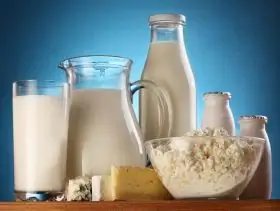2026 Author: Howard Calhoun | [email protected]. Last modified: 2025-01-24 13:10:31
The technology of product pasteurization is named after the French microbiologist Louis Pasteur, who lived at the end of the nineteenth century. Its essence lies in the one-time heating of products of a liquid consistency, which leads to disinfection from various microorganisms. This allowed to increase the shelf life of products. Initially

technology was designed for beer and wine.
This preservation method is widely used in the processing of dairy products. Pasteurization of milk is the process of heating to a temperature close to boiling, and the destruction of pathogens without changing the basic properties - smell, texture and taste.
The main task of milk pasteurization is to prevent its premature sourness, which is caused by lactic acid bacteria, as well as the reproduction of Escherichia coli and other microorganisms.

In industrial production, the reaction to phosphatase is used to control the effectiveness of pasteurization. If the reaction is negative, all non-spore-forming pathogenic bacteria are considered dead. The efficiency of the process will be high only if, immediately after milking, the milk was cooled to a certain temperature and stored at it until pasteurization. For this, special cooling tanks are used on livestock farms.
In practice, milk can be pasteurized in three different ways.
Long pasteurization - milk is heated to a temperature of 65 degrees and maintained in this state for half an hour.
Short-term pasteurization - heating occurs up to 75 degrees and after twenty seconds the processing stops.
Instant pasteurization of milk is heating it to a temperature of 85 degrees - and immediately cooling. If pasteurization of milk was done instantly, there is a change in the physico-chemical properties of some elements, due to which its taste qualities change.
Milk production equipment is used only on an industrial scale. At home, pasteurization can be done using a double boiler. First you need to sterilize the container in which the milk will be stored by placing

her in an ordinary oven at a temperature of about one hundred degrees for about twenty minutes. Or you can do it the traditional way with steam.
Next, milk is poured into the upper chamber of the double boiler and a thermometer is placed so that it does not touch the walls, and water is placed into the lower chamber. Milk is brought to a temperature of 65 degrees and constantly stirred for thirty minutes. It is important to keep track ofso that the temperature does not rise.
If the milk is heated to 75 degrees, then pasteurization should be carried out only for fifteen minutes. After that, the container with milk must be immersed in ice water, without ceasing to stir, until the temperature drops to four degrees Celsius.
After that, the milk is poured into a sterilized container, closed with a lid and put in the refrigerator. For two weeks, you don't have to worry about it going sour.
Recommended:
Payment of the loan "Home Credit". Methods of payment for the loan "Home Credit"

You can repay the Home Credit Bank loan in several ways. Each client has the opportunity to choose the most convenient payment option. We will consider the payment methods for the Home Credit loan in more detail
Home economy. Personal finance management. How to keep a home budget

Households are considered political economy as one of the four basic elements of the economy, and we will now consider the features of personal finance management within this object
Home business for men: ideas, options and benefits of a home business

A good way to make money is a home business for men. The most numerous ideas, and most importantly, allow you to earn money without large investments
What is milk made of? How is milk powder made?

Surely everyone is concerned about the question of what milk is made of. In this article we will try to find answers to it and learn a lot about this product familiar from childhood
Partridges: breeding and keeping at home. Breeding and keeping partridges at home as a business

Breeding partridges at home as a business is a wonderful idea, because so far it is exotic to some extent, does not require significant investments at the start (or even none at all), there is no special knowledge for growing an unpretentious and little sick bird need. And demand today exceeds supply. This business can be especially interesting in small towns and villages where there are problems with employment and other types of earnings

